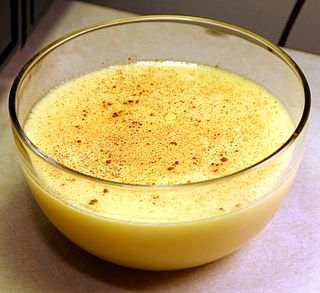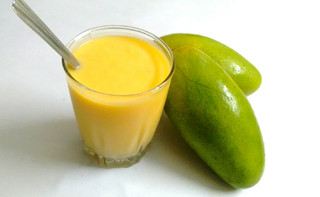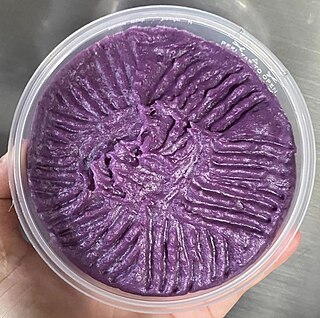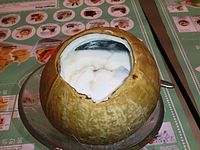
Dessert is a course that concludes a meal. The course consists of sweet foods, such as cake, biscuit, ice cream and possibly a beverage such as dessert wine and liqueur. Some cultures sweeten foods that are more commonly savory to create desserts. In some parts of the world there is no tradition of a dessert course to conclude a meal.

Blancmange is a sweet dessert popular throughout Europe commonly made with milk or cream and sugar thickened with rice flour, gelatin, corn starch, or Irish moss, and often flavoured with almonds.

Custard is a variety of culinary preparations based on sweetened milk, cheese, or cream cooked with egg or egg yolk to thicken it, and sometimes also flour, corn starch, or gelatin. Depending on the recipe, custard may vary in consistency from a thin pouring sauce to the thick pastry cream used to fill éclairs. The most common custards are used in custard desserts or dessert sauces and typically include sugar and vanilla; however, savory custards are also found, e.g., in quiche.

Pudding is a type of food. It can be either a dessert, served after the main meal, or a savoury dish, served as part of the main meal.
Po‘e or poke is a Polynesian pudding usually eaten as a dessert.

Chocolate puddings are a class of desserts in the pudding family with chocolate flavors. There are two main types: a boiled then chilled dessert, texturally a custard set with starch, commonly eaten in the U.S., Canada, Germany, Sweden, Poland, and East and South East Asia; and a steamed/baked version, texturally similar to cake, popular in the UK, Ireland, Australia, Germany and New Zealand.

Kūlolo is a Hawaiian dish made with taro and coconut. Considered a pudding, kūlolo has a chewy and solid consistency like fudge or Southeast Asian dodol, with a flavor similar to caramel or Chinese nian gao. Because taro is widely cultivated on the island of Kauai, taro products such as kūlolo is often associated with the island. It is a well-beloved dish well documented by many non-Hawaiians since the late 1800s, sometimes found during festive occasions like at lūʻau.

Tacca leontopetaloides is a species of flowering plant in the yam family Dioscoreaceae. It is native to Island Southeast Asia but have been introduced as canoe plants throughout the Indo-Pacific tropics by Austronesian peoples during prehistoric times. They have become naturalized to tropical Africa, South Asia, northern Australia, and Oceania. Common names include Polynesian arrowroot, Fiji arrowroot, East Indies arrowroot, pia, and seashore bat lily.

Fijian cuisine has long consisted of primarily foraged and farm-grown food. Although rice, wheat, and tea all became staples during Fiji's colonial era, native Fijians still eat primarily tubers and coconuts. The cuisine of Fiji is known for its seafood and various green vegetables, including ''ota'', a young forest fern, and ''bele'', a plant that resembles spinach.

Kalamai is a traditional Chamorro corn / coconut pudding, sometimes referred to as coconut gelatin. Original versions of kalamai called for masa harina, coconut milk, sugar, and water. Subsequently, cornstarch has been used to thicken the dessert. Red or green food coloring may be used to color the kalamai, followed by a sprinkling of cinnamon on the surface. A few recipes add vanilla for additional flavoring.

Niue is an island in the Southern Pacific, mostly inhabited by Polynesians. The plantations are mostly filled with manioc, taro and breadfruit, but banana trees can be found. The wide range of exotic plants in Niue includes taros, pawpaw, coconuts, bananas, yams, cassavas and breadfruits: All are intensively used in the local cuisine.

Native Hawaiian cuisine refers to the traditional Hawaiian foods that predate contact with Europeans and immigration from East and Southeast Asia. The cuisine consisted of a mix of indigenous plants and animals as well as plants and animals introduced by Polynesian voyagers, who became the Native Hawaiians.

Poi is a traditional Samoan dessert made from mashing fruit into a smooth consistency and mixing in coconut milk and other flavourings.
Pie in American cuisine has roots in English cuisine and has evolved over centuries to adapt to American cultural tastes and ingredients. The creation of flaky pie crust shortened with lard is credited to American innovation.

Kōʻelepālau, or pālau, is a Hawaiian pudding made primarily with cooked sweet potatoes mixed with coconut cream. It is similar to other Native Hawaiian puddings like kūlolo and piele.















